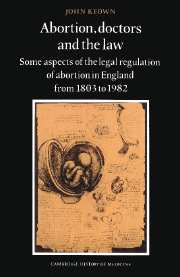 Abortion, Doctors and the Law
Abortion, Doctors and the Law Book contents
- Frontmatter
- Contents
- Table of cases
- Table of statutes
- Acknowledgements
- Introduction
- 1 The first statutory prohibition of abortion: Lord Ellenborough's Act 1803
- 2 Anti-abortion legislation 1803–1861 and medical influence thereon
- 3 Abortion in legal theory and medical practice before 1938
- 4 The medical profession and the enactment of the Abortion Act 1967
- 5 The Abortion Act 1967 and the performance of abortion by the medical profession 1968–1982
- 6 The reaction of the medical profession to proposed restriction of the law 1969–1979
- 7 A theoretical overview
- Appendices
- Notes
- Subject index
- Names index
2 - Anti-abortion legislation 1803–1861 and medical influence thereon
Published online by Cambridge University Press: 26 October 2009
- Frontmatter
- Contents
- Table of cases
- Table of statutes
- Acknowledgements
- Introduction
- 1 The first statutory prohibition of abortion: Lord Ellenborough's Act 1803
- 2 Anti-abortion legislation 1803–1861 and medical influence thereon
- 3 Abortion in legal theory and medical practice before 1938
- 4 The medical profession and the enactment of the Abortion Act 1967
- 5 The Abortion Act 1967 and the performance of abortion by the medical profession 1968–1982
- 6 The reaction of the medical profession to proposed restriction of the law 1969–1979
- 7 A theoretical overview
- Appendices
- Notes
- Subject index
- Names index
Summary
This chapter considers the scope of Lord Ellenborough's Act and its successors, which were enacted in 1828, 1837 and 1861, and examines their prohibition of abortion in the light of contemporary medical opinion.
Anti-abortion legislation 1803–1861
Lord Ellenborough's Act was, it will be recalled, severe. Section 1 punished with death ‘any person or persons’ who administered ‘any deadly poison, or other noxious and destructive substance or thing’ with intent to procure the miscarriage of ‘any woman, then being quick with child’. Section 2 went further and punished, with a variety of non-capital penalties, ‘any person or persons’ who administered ‘any medicines, drug, or other substance or thing whatsoever’ or who used ‘any instrument or other means whatsoever, with intent thereby to cause or procure the miscarriage of any woman not being, or not being proved to be, quick with child at the time of administering such things or using such means …’. Only s. 2, therefore, punished instrumental attempts. This anomaly was removed by the next statute to deal with abortion, Lord Lansdowne's Act 1828. Section 13 of the Act, which replaced ss. 1 and 2 of Ellenborough's Act, extended the prohibition on postquickening abortion to include attempts involving ‘any instrument or other means whatsoever’. Moreover, the strict penalties for abortion, whether before or after quickening, remained substantially unchanged, although in the case of the latter the accused was no longer deprived of benefit of clergy and, on conviction for the former, the court could no longer fine or condemn to the pillory.
- Type
- Chapter
- Information
- Abortion, Doctors and the LawSome Aspects of the Legal Regulation of Abortion in England from 1803 to 1982, pp. 26 - 48Publisher: Cambridge University PressPrint publication year: 1988


